This guide will help me with the basic information on Cloudjiffy dashboard usage and to get acquainted with the possibilities it provides.
Here is a list of main sections:
- Creating and Managing Environments
- Function Icons for Environments
- Function Icons for Each Instance
- Import
- Marketplace
- Deployment Manager
- Tasks Panel
- Account Settings
- Upgrade Trial Account & Balance
- Additional Options: Search Box, Help, Email Address
Creating and Managing Environments
1. Click NEW ENVIRONMENT in the upper left corner of the dashboard.
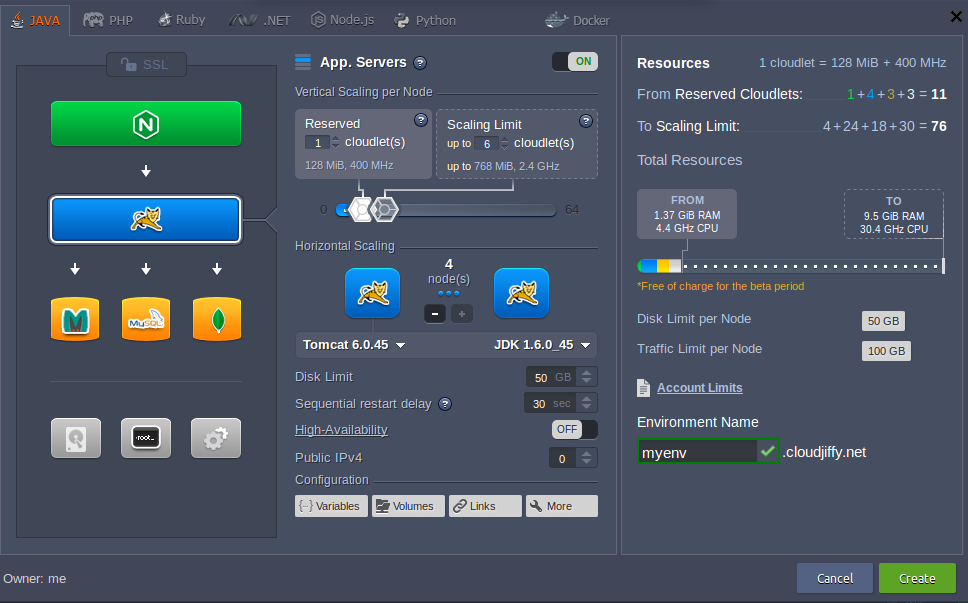

2. The status column shows the permanent state of my environment (Running, Sleeping, Stopped) or some temporary interim process it is currently undergoing (Creating, Launching, Stopping, Cloning, Exporting, Installing, Migrating, Deleting).
3. Tags column indicates the name of the owner who created the environment.
4. Usage column shows the number of cloudlets and percentage of available disk space that environment currently consumes. I can also find the Billing history button
Function Icons for Environments
The main icons are as follows :
1. Open in browser
2. Settings
3. Clone environment
4. Change environment topology
5.Delete environment

1. Click the Open in browser icon![]() to open the environment in a new browser tab.
to open the environment in a new browser tab.
Note that this option could be absent in case my environment consists of Docker-based containers or just does not include an application server (i.e. no web interface is handled inside).
2 Click on Settings to![]() open a separate tab with a number of configuration sections. There are ten options here: Custom domains, Custom SSL, SSH Access, Monitoring, Endpoints, Migration, collaboration, Change Owner, Export and Info.
open a separate tab with a number of configuration sections. There are ten options here: Custom domains, Custom SSL, SSH Access, Monitoring, Endpoints, Migration, collaboration, Change Owner, Export and Info.
- Select Custom domains to access the following suboptions: Domain binding, and Swap domains

-
Choose the Custom SSL option and upload the necessary files in order to apply my custom SSL Certificate.

-
Select Monitoring in order to start tracking the number of resources my environment consumes.

Use Load Alerts for setting new triggers (or adjusting the default ones) to receive special email notifications in case the specified resource’s usage exceeds the stated limits.
Within the Auto, Horizontal Scaling suboption I can configure triggers for changing the amount of my web/application nodes depending on CPU, Memory, Network, Disk I/O or Disk IOPS consumption.
The Events History section contains records about all the events that occurred due to the configurations, set using the two abovementioned sections.
- Within the Endpoints section, I can manage to map of my containers’ TCP/UDP ports for ensuring their collaboration with external resources via direct connection

- Select collaboration to see the list of accounts which have access to the current environment.

-
If I need to share the environment with another account, click Add and fill in the Email field. I can also tick Change Topology / SSH Access if I would like to give such permissions to a user. Click Save.
-
Click Change Owner in order to transfer environment to another user account within the confines of a single platform.

-
Select Export in order to pack all my environment’s settings and data into a single downloadable file, that can be subsequently restored at another hosting provider’s platform for the creation of the identical and ready-to-use environment.
Note that this feature is not currently available for Windows and Docker-based containers.

Switch to the Info section to see additional information on environment domain (except environments without application server), its creator/owner (as they can differ due to the account collaboration feature), hardware region it belongs to and the date/time of creation.

4. To Clone the environment, click on the appropriate button![]() . In the opened frame, specify the name for the new environment and click Clone.
. In the opened frame, specify the name for the new environment and click Clone.
5. In order to Change the environment topology, select the needed option.![]() Perform the required changes in the appeared Environment topology dialogue box and click Apply to submit them.
Perform the required changes in the appeared Environment topology dialogue box and click Apply to submit them.
6. To Delete an environment, click on the red cross icon and![]() confirm that I really want to do this by entering my password.
confirm that I really want to do this by entering my password.
Function Icons for Each Instance
Over a particular instance or container to see the pop-up icons with different functions.

Use these icons to perform the following actions:
-
Click the Open in browser option to open the application server, database, balancer, VPS node, Docker container or application context in a new browser tab.
-
In order to Restart node, select the same-named option and confirm my decision. In just the same way this can be done for a set of the same-type nodes.
-
Select the Config option to open the Configuration Manager tab, where I can change the node’s settings by means of uploading and modifying files.
-
Select the Log option to view the log files for a separate node or for the set of the same-type ones. Log files list can differ depending on the selected instance.
-
Select the Statistics option to track the data on CPU, RAM, Network I/O and Disk space consumption for a separate node or a set of nodes in a real time.
-
Some nodes can also have optional buttons, such as Add-ons (for installing available pluggable modules) and Add project (for deploying apps via GIT/SVN).
When hovering over a separate node, I’ll see one more Set-Alias icon. It allows me to set an alternative name for my node instead of the default Node ID label (e.g. to define master and slave servers in a DB cluster). The same thing can be done with the environment name, wherein its domain name will remain the same.
icon. It allows me to set an alternative name for my node instead of the default Node ID label (e.g. to define master and slave servers in a DB cluster). The same thing can be done with the environment name, wherein its domain name will remain the same.

Import
Next, to the New environment option, I can find the Import button. It allows to upload .json, .jpsor .cs file in order to create new environment (or modify the already existing one with an add-on) according to the settings, declared in it.
![]()
-
Local File - select the locally stored file (via the Browse button), that should be uploaded and executed on a Platform
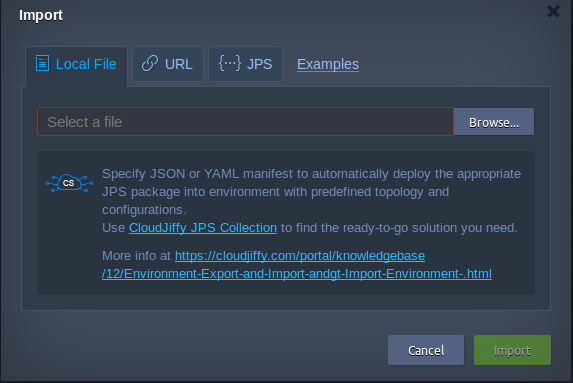
- URL - type in or paste a direct link to the required manifest file
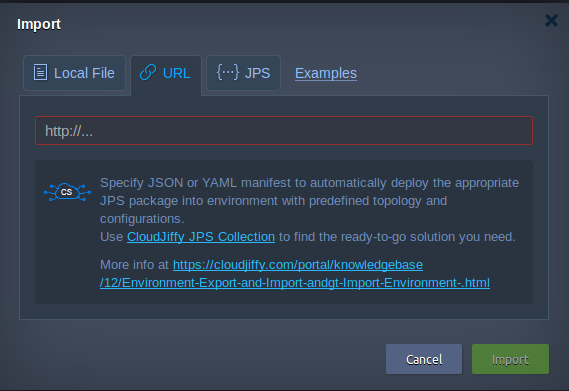
- JSON - the inbuilt JSON editor can be used to insert and edit my code before the deployment, or even to declare my package from the scratch manually
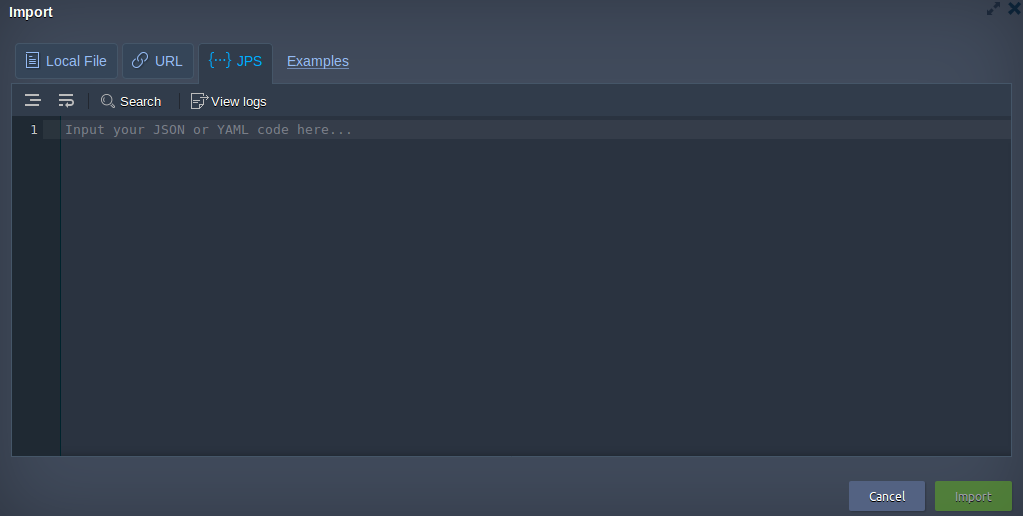
Marketplace
Upon clicking on the last Marketplace option at the top dashboard panel, I’ll access a separate frame with the Apps, Add-ons and Containers sections inside.
![]()
-
The first Apps tab provides access to the list of preconfigured packaged applications.
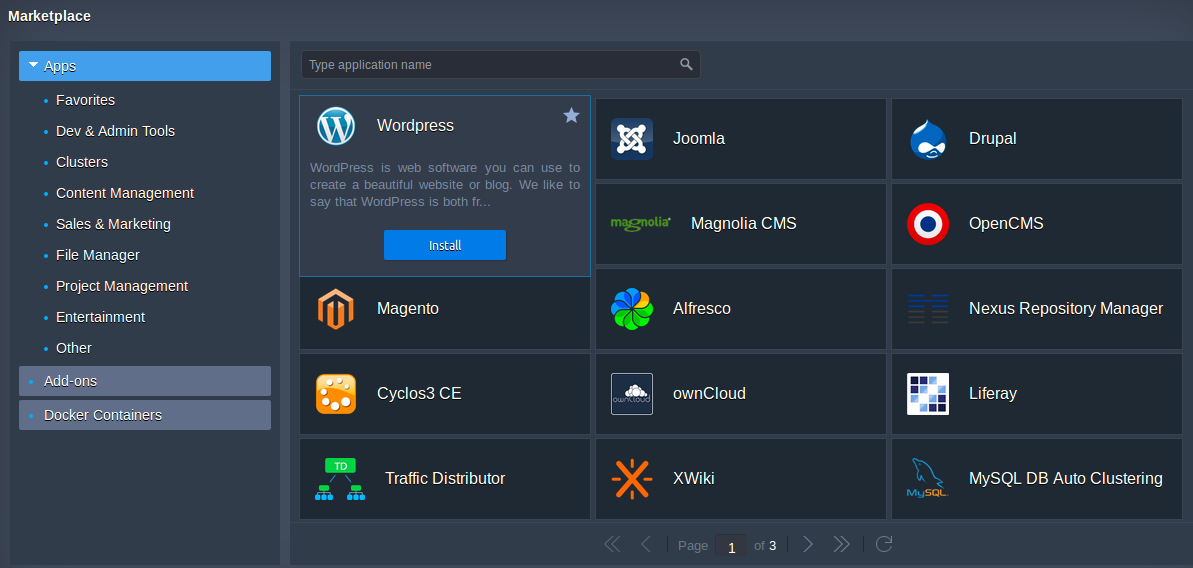
Locate the desired package (using the categorized list or search box) and click Install in order to automatically create an appropriate environment and deploy the chosen application to it.
-
Within the Add-ons section, I can find a number of modules, which can be installed on top of the existing environment to modify it and get the advanced functionality.
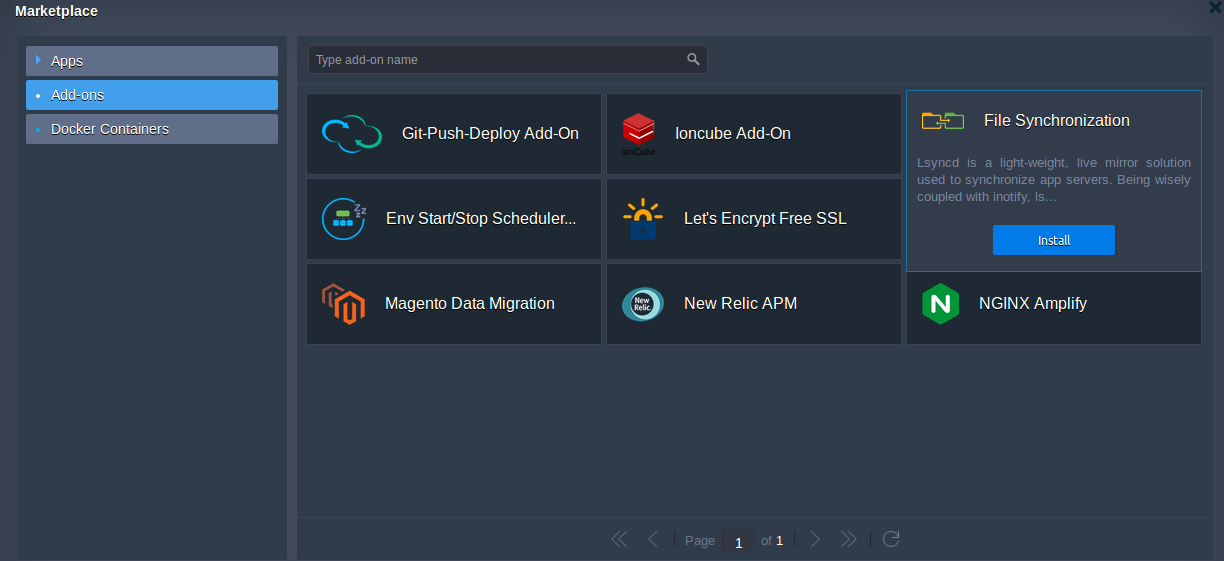
- Choosing the Docker Containers suboption will open the panel, where I can find and subsequently deploy the desired Docker image through one of the available tabs:
- Search allows finding the required template within the official Docker Registry Hub
- The custom section provides the ability to add my own template from a custom registry
- Favourites tab lists solutions I’ve previously marked as favourite (with the gold star in the top right plank corner) to quickly access them
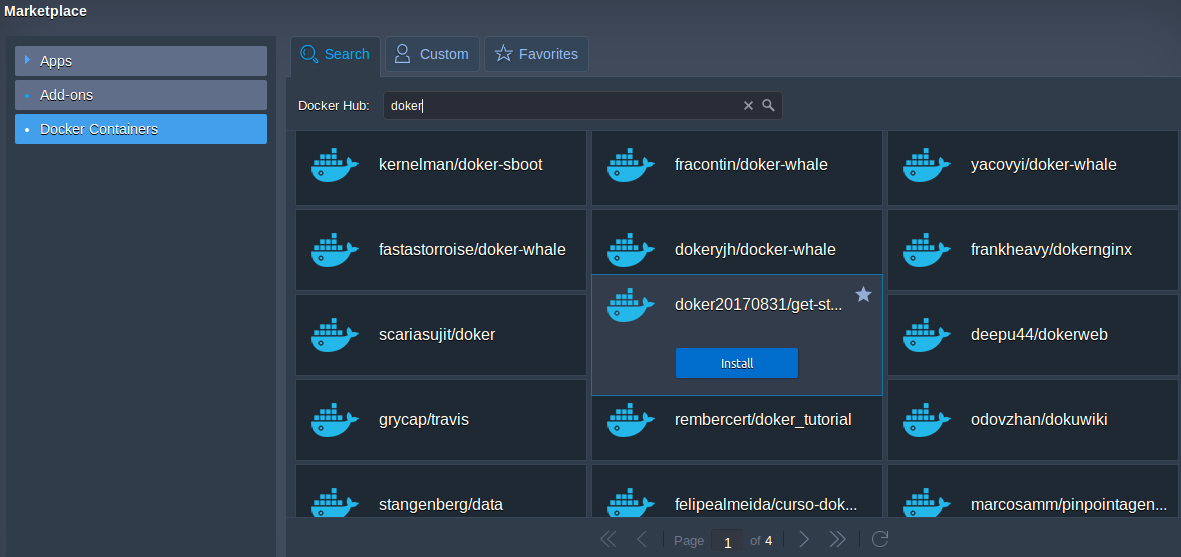
The Deployment Manager is used to upload application packages and subsequently deploy them to an application server of my running environment.
1. Click the Upload button to access the Upload archive dialogue box. Using it I can browse to the desired local file or specify a URL (http://, https:// or ftp://) in the appropriate tab.
Fill in the Comment field if required and then click Upload.
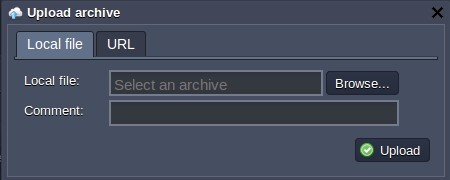
2. Select the uploaded file and click the "Deploy to" button to see the list of suitable environments. Choose the one I would like to deploy my application to.

3. In the opened dialogue box, I can either just confirm the deployment (in this case the default root context will be used) or optionally set the desired custom context. Herewith, depending on the programming language used, this should be performed as follows:
- for Java/PHP/.NET - type the context name to the special field
- for Ruby - choose out of the proposed variants
-
for Python and Node.js - a single predefined deployment path is used, thus specifying my custom contexts for these programming languages is not available
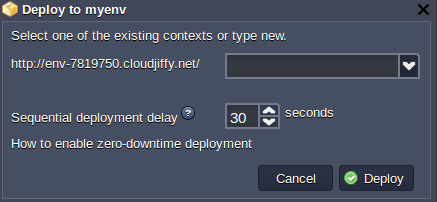
Click Deploy to initiate the process itself.
In our Deployment Guide, I can find a number of links to the instructions on different apps deployment, according to the programming languages they have been written in.
Tasks Panel
The Tasks panel is placed at the very bottom of the dashboard and contains live and historical data on the tasks that Cloudjiffy engine is doing or has already done.

- When the action has taken place
- What has been performed
- Result of this action (i.e. Success if everything is OK or an error description if some problem occurred)

Task panel tracks all global processes (like Creating an environment, Adding node(s) or Deploying context), as well as the subsequent changes and actions performed in the File manager (Creating a file, Renaming a file, Uploading file etc).
Account Settings
Click the Settings button at the top-right corner of the dashboard in order to access a few more configurations, which are applied to the whole account.![]()
I’ll see two sections available here: SSH Keys and Collaboration.
-
SSH Keys - here I can find general information on the SSH protocol usage at Cloudjiffy and several useful links to our documentation with instructions for both private and public SSH keys. The same-named subsections can be found within the menu to the left.
The Private one gives me the possibility to add the pre-generated private SSH keys to my Cloudjiffy account. Subsequently, they can be used for authentication at my private GIT/SVN repositories, allowing to work with the remote secured projects directly from the Cloudjiffy dashboard.
The Public subsection allows binding of a public SSH key to my account, required for getting the ability to securely access and manage my containers via this protocol.
The Collaboration option includes two items - Account Management and Shared with Me. Here, the first one allows me to share certain activities with other accounts by means of creating and configuring my own collaboration, while the second one is intended for managing the already shared with my accounts..
Additional Options: Help, Email Address
- Help (Contact support, Docs, API docs, Video, Go to community, Show Cloudjiffy tutorial)
-
Email address (Change password, Language, Sign out)
2. The Help drop-down menu gives me access to the Contact support, Docs, API docs, Cloudjiffy CLI, Video, Go to community and Show Cloudjiffy tutorial options.
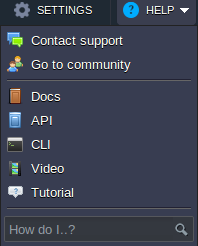
- Contact support is a hyperlink to my hoster's Support page (sometimes available only for billing users)
- The Docs option is a hyperlink to the Cloudjiffy Devs Documentation
- The API docs option is a hyperlink to the Cloudjiffy API Documentation
- The Video option is a hyperlink to the Cloudjiffy Youtube Channel
- The Cloudjiffy CLI option is a hyperlink to the Cloudjiffy CLI Overview
- The Go to community option links to the Cloudjiffy online community
3. The last option is my Login (email address). Click on it to open the drop-down list with the following options: Change password, Language and Signout.

- Click Change password to open the same-named dialogue box. Fill in the required fields (Current password, New password and Confirm password) and confirm my entries with the Change password button.
- Use the Language option to change the localization of the dashboard interface.
- Click Sign out to leave the dashboard.
Now I know all of the basic dashboard possibilities and hopefully won’t have any problems in using it. If I still have additional questions, please contact the Support team of my hosting provider.